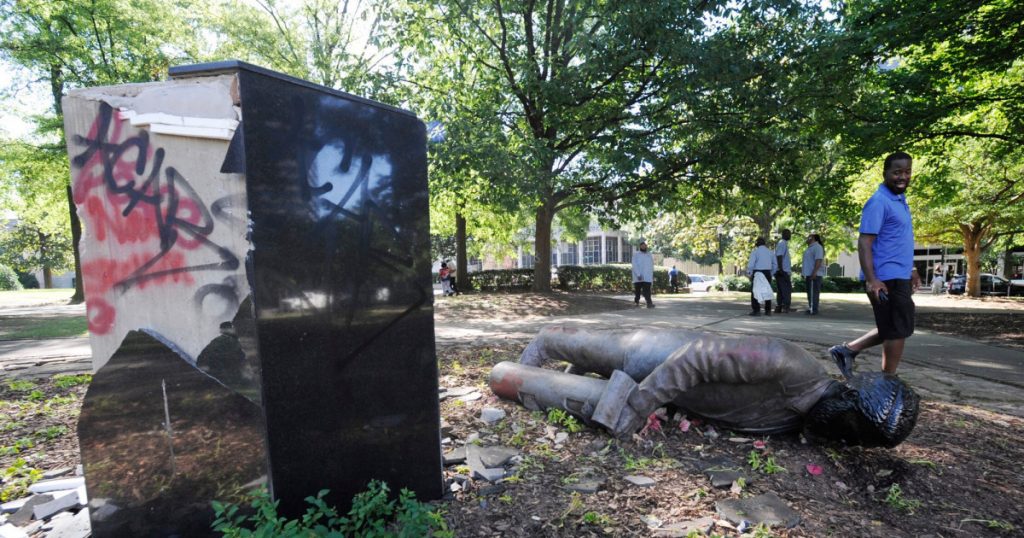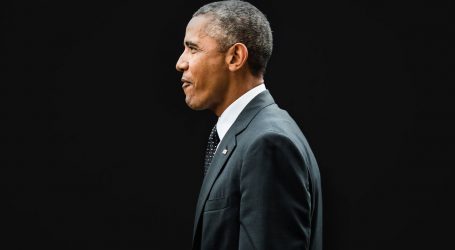All the Monuments to Racism That Have Been Torched, Occupied, or Removed
A man walks past a toppled statue of Confederate Charles Linn in Birmingham, Alabama June 1, 2020.(AP Photo/Jay Reeves)
For indispensable reporting on the coronavirus crisis and more, subscribe to Mother Jones’ newsletters.For all the handwringing over the “senseless” property destruction that has accompanied the past week of protest, a number of the damaged sites have a perfectly sensible connection to the protesters’ chief grievance: anti-Black racism. Throughout the South, protesters have burned buildings and toppled statues that have stood for years as overt reminders of the country’s history of chattel slavery, racial apartheid, and the war fought to uphold it.
Most of these Confederate monuments were built not immediately after the Civil War but in the Jim Crow South of the early 20th century, as a part of white Southerners’ cult of the “Lost Cause.” In this relitigation of history, Confederate soldiers were not landed gentry fighting to maintain their right to own other human beings (which they were). Instead, they were posited as noble rebels, fighting outmatched against a tyrannical government for a right to “maintain their way of life.” The plaques and obelisks and statues that dotted cities around the South in memory of this myth were designed as points of nostalgic pride for white Southerners and ominous reminders of systemic racial terror for Black Southerners.
We’ve debated for years about whether these symbols of the Rebel South should continue to exist, but now, perhaps emboldened by the historic moment, people around the country (and now around the world) have taken matters into their own hands. Here’s a running list—updated June 8—of what’s been hit so far.
The monument to Confederate soldier John Castleman was quietly removed by the city of Louisville on June 8. The statue had been the subject of debate, and last year a local arts group sued the city to prevent the statue’s removal. But on June 5 a Jefferson Circuit Court judge maintained the city’s right to take it away.
Breaking: The statue of Confederate soldier John Castleman is currently being removed by the city of #Louisville at Cherokee Triangle. pic.twitter.com/3yPyELbXvf
— Ben Tobin (@TobinBen) June 8, 2020
City workers on June 8 dismantled and removed a monument to Confederate soldiers who died in a Union prison camp. The monument, which was originally erected in a nearby cemetery, was moved to Garfield Park in 1928 by public officials who were also members of the Ku Klux Klan and wanted to “make the monument more visible to the public,” according to a news release from Indianapolis Mayor Joe Hogsett.
Down it goes. A monument dedicated to Confederate soldiers who died at a Union prison camp in Indianapolis is being dismantled from Garfield Park Monday morning. pic.twitter.com/Yi53OAQOvi
— Mykal McEldowney (@mykalmphoto) June 8, 2020
During a Black Lives Matter protest on Sunday, June 7, demonstrators in Bristol, England, pulled down a statue of slave trader Edward Colston, who made a fortune in the Atlantic slave trade in the 17th and 18th centuries. The monument to Colston and his philanthropy now rests in a watery grave—it was rolled down a street and thrown it into a nearby harbor.
The moment a statue of slave trader Edward Colston toppled into Bristol’s harbour. ‘It’s what he deserves. I’ve been waiting all my life for this moment’ someone told me in the moments after. pic.twitter.com/6juqVrsJ6V
— Sarah Turnnidge (@sarah_turnnidge) June 7, 2020
Protestors occupied a statue of Belgian King Leopold II, waving the flag of the Democratic Republic of Congo and chanting “murderer.” Leopold is infamous for the atrocities committed in Congo under his rule in the 19th century, including the murder of between one and 15 million Congolese people. An online petition has since been launched to remove all statues of Leopold throughout the city.
A crowd has climbed onto the statue of colonial King Léopold II in #Brussels chanting “murderer” and waving the flag of the Democratic Republic of Congo where his atrocities took place. #DRC 🇨🇩 #BlackLivesMatter pic.twitter.com/DIH9MGu39M
— Jack Parrock (@jackeparrock) June 7, 2020
On June 5 Fredricksburg removed a 176-year-old slave auction block that stood on a downtown street corner. Unsurprisingly, the block had been a site of contention for years. In 2017 after white supremacists descended on Charlottesville in the deadly “Unite the Right” rally, Fredricksburg’s sole Black city council member Chuck Frye Jr. proposed removing the block but was voted down, according to CNN. In recent protests, people spray painted the block and chanted for it to be moved, and it finally was.
BREAKING: 176-year-old slave auction block removed from street corner in downtown Fredericksburg, Virginia pic.twitter.com/EnyEtvAiON
— US Protests: News & Updates (@USAProtests) June 5, 2020
The US Marine Corps announced June 5 that it would ban displays of Confederate flags from ” public spaces and work areas” on their bases. It begs the question of why the Rebel flag was allowed on the bases of a branch of the US military in the first place.
Overnight on June 4, the government of Mobile quietly removed a statue of Confederate navy officer Raphael Semmes that had stood in the city’s downtown since 1900. Earlier in the week, a man had tagged the statue with graffiti phrases including “confed scum.” He was later arrested, and the city workers cleaned the statue, according to local news.
A woman dances at the spot where a confederate statue was removed in downtown Mobile, Alabama this morning.https://t.co/yrLIZKVzWH pic.twitter.com/7Cu5e9SR3Q
— ABC 33/40 News (@abc3340) June 5, 2020
Philadelphia officials on June 3 removed the statue of former Mayor Frank Rizzo that had previously stood in front of the city municipal building. The statue had been a target of protesters in recent years, and with good reason. Rizzo was an avatar of white reaction, first as a “tough on crime” police commissioner from 1968–71 and then as mayor from 1972–80. As commissioner, his policies resulted in a pattern of racist police brutality against Black residents, and as mayor, he fought desegregation efforts, blocked public housing, and urged people to “vote white.” In a statement ahead of the removal, which had originally been planned for 2021, current Philadelphia Mayor Jim Kennedy said: “The statue is a deplorable monument to racism, bigotry, and police brutality for members of the Black community, the LGBTQ community, and many others. The treatment of these communities under Mr. Rizzo’s leadership was among the worst periods in Philadelphia’s history.” On Sunday, June 7, city crews painted over a mural of Rizzo in South Philadelphia
Protests get results: The Rizzo statue is gone https://t.co/Z6webXiy8U pic.twitter.com/Ov0gxGB5p4
— Billy Penn (@billy_penn) June 3, 2020
The government of Alexandria had been planning to move this statue of a southern-facing Confederate soldier for some time now. But apparently the good ol’ gals of the Daughters of the Confederacy who own the statue decided to speed things along and preemptively had it removed on June 2.
Alexandria, like all great cities, is constantly changing and evolving. pic.twitter.com/CZTjlOkpfT
— Justin Wilson (@justindotnet) June 2, 2020
Demonstrators took down a bronze statue of Charles Linn, erected in the center of an eponymous park in honor of a sea captain who volunteered to help the Confederacy in the Civil War. They also attempted to bring down a nearby obelisk monument to Confederate soldiers and sailors until Birmingham Mayor Randall Woodfin deterred them, saying “allow me to finish the job for you.” Johnson promised that the statue would be removed by Tuesday, June 2 at noon, and by Monday night it was gone.
#Protesters tear down Confederate statue in #Birmingham, #Alabama
DETAILS: https://t.co/fTYBaYsJkR pic.twitter.com/KgyOyuThJK
— RT (@RT_com) June 1, 2020
24 hours ago, Birmingham’s mayor told protesters that if they stopped trying to dismantle the confederate monument, he’d have it removed safely within 24 hours. The city is currently following through on its word, and the monument will soon be down. pic.twitter.com/wpRNJ1jyph
— David Griner (@griner) June 2, 2020
Richmond’s Monument Avenue, built explicitly to honor Confederate soldiers at the turn of the 20th century, has frequently been a flashpoint in the nationwide debate about the removal of Confederate symbols. Over the weekend of May 30, the statues of Confederate idols Robert E. Lee, Stonewall Jackson, Jefferson Davis, and others were tagged with such phrases as “No More White Supremacy” and “Blood on Your Hands.” In demonstrations Monday, protesters attempted to pull some statues down, according to police. They were met with tear gas. Virginia Governor Ralph Northam announced on June 4 that the Robert E. Lee statue would be removed “as soon as possible.”
Aftermath of last night’s #richmondprotest Taken on Monument Avenue in RVA this morning. pic.twitter.com/nAWoAAx5nm
— Brooks Sharrett (@Brooks182) May 31, 2020
BREAKING NEWS: Police say protesters are attempting to pull down Confederate statues located on Monument Avenue in downtown Richmond. https://t.co/uAIum1BBSX
— NBC12 WWBT Richmond (@NBC12) June 2, 2020
The United Daughters of the Confederacy was founded in 1894, dedicated to “the purpose of honoring the memory of its Confederate ancestors” and “protecting, preserving and marking the places made historic by Confederate valor.” In practice, this has meant serving as the standard-bearers of Lost Cause ideology, constructing and defending over 450 Confederate monuments across the South. The Richmond headquarters of the organization was set on fire during protests overnight on May 31. It was later put out by firefighters.
Multiple reports say the national hall of the Daughters of the Confederacy in Richmond, Virginia, has been set on fire. https://t.co/O8wZpHHwWy
— Angus Johnston 😷 (@studentactivism) May 31, 2020
It appears, however, that some Stonewall Jackson memorabilia inside the building was destroyed before firefighters could get to it. How sad.
hell yeah pic.twitter.com/ZYCSf5mrEn
— Talia Lavin (@chick_in_kiev) June 1, 2020
Built in 1932, this statue was paid for by—you guessed it—the Daughters of the Confederacy, to honor “the Confederate Defenders of Charleston.” Engraved around the base are the words “Count Them Happy Who for Their Faith and Their Courage Endured a Great Fight.” On May 31 protesters crossed out the word “courage” with spray paint and replaced it with “traitors.” The statue has since been covered up.
Statue dedicated to “Confederate Defenders” at the Battery in downtown Charleston tagged with spray paint amid #georgefloyd protest #chsnews pic.twitter.com/kZHCFyZKkd
— Jackson Helms (@Jackson_Live5) May 30, 2020
Protesters blocked traffic on I-630 in Little Rock on May 30. The construction of the highway in the 1960s and 1970s cut through a Black community and business district and created a barrier that further segregated the city, just like many, many, many other highways constructed in post-war America.
If you are from central AR you know that 630 represents the segregation and redlining that still exists in Little Rock, 60 years after LR Nine and the civil rights movement. This is monumental. https://t.co/gBv0lKQ3Ko
— mad (@ennaenieledam) May 31, 2020
In 1906, Nellie Durham Deupree and her band of Lost Cause ladies commissioned this monument for all the usual Lost Cause reasons. It’s long been decried as a racist symbol by some Ole Miss students, and in March 2019 the student government voted unanimously to have it removed. But in January of this year, the university’s governing board delayed a vote on whether to move it. Over the weekend of May 30 a man tagged the statue with the words “spiritual genocide.” He was later arrested.
The Confederate Statue on the University of Mississippi campus was vandalized this evening by an unidentified male. The words “spiritual genocide” were spray-painted on all sides of the statue, along with red handprints. @OxfordEagle will have more updates as they are available. pic.twitter.com/Faf5ijnbEP
— Anna Guizerix (@annalaurenguiz) May 30, 2020
Today Fayetteville’s Market House is mainly a historical landmark and tourist attraction, but as its name suggests, it was previously a commercial center and site where slave auctions were held. It was burned in protests on Saturday, May 30, but by Sunday people had come to clean it up.
The Market House in downtown Fayetteville is on fire. Protestors have shattered the windows and are chanting,”Black Lives Matter.” pic.twitter.com/7vUGPrPKnB
— Akilah Davis (@DavisABC11) May 30, 2020
Raleigh, North Carolina, a capital city in the United States of America, has sitting in front of its state government building a monument to the soldiers of the Confederate States of America, a failed slaveholding republic that resulted from an attempt of treason against the United States government. This monument was spraypainted by protesters over the weekend of May 30, presumably violating the 2015 state law that prevents such monuments from being removed, destroyed, or altered.
Confederate Monunent at the State Capitol vandalized. #F12, it says. Grafiti also says “racist”and “buck the system.” #RaleighDemandsJustice, #GeorgeFloydprotest pic.twitter.com/1hg3wbG3BQ
— Ashad Hajela (@ashad_hajela) May 31, 2020
Correction: A previous version of this article misidentified the mayor of Birmingham, Alabama. He is Randall Woodfin.





